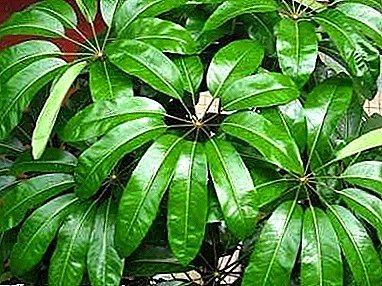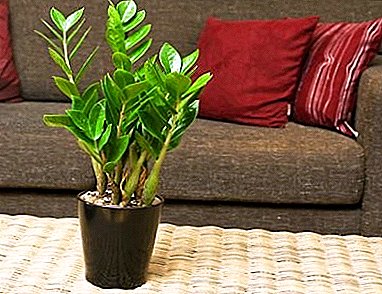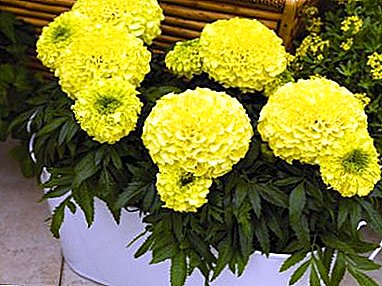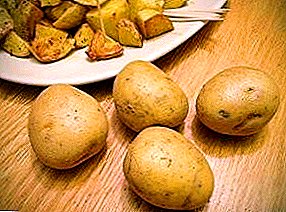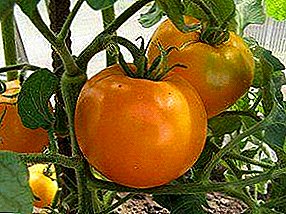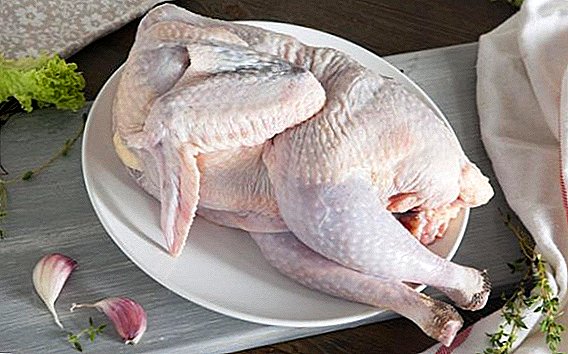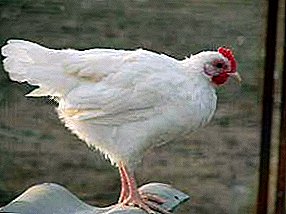
Russian white chickens - this is one of the most famous egg breeds in Russia. It is for this reason that these chickens are most often found on domestic poultry farms, and their eggs are found in stores and in the markets.
This breed of chickens was obtained relatively recently, in the years 1930-1953. Breeders were able to get them by crossing white Leghorn cocks with native outbred chickens.
At the same time, white Leghorny with different origins took part in the selection process for selection of birds: English, Danish, and American.
All Russian white chickens have their own characteristics in the exterior and productivitythat could be effectively combined with each other.
The breeding work of experienced Russian breeders was aimed at increasing the overall egg-laying capacity, endurance, precocity and live weight of the bird.
Until 1965, on the territory of the USSR, exclusively Russian white chickens were used as egg chickens. Their average productivity was almost 190 eggs per year, having a mass of 60 g. In breeding poultry farms, breeders managed to breed Russian white chickens with egg production of 200 or more eggs per year.
Due to low competitiveness, the number of this breed in 1990 was reduced to 3 million individuals (in 1975 it amounted to almost 30 million individuals). Now this breed has retained its former livestock in the territory of Turkmenistan, Azerbaijan and Uzbekistan.
Russian breeders continue their work on this breed, hoping to somewhat improve its egg production and endurance. It is assumed that in the future, Russian white chickens will be able to better compete with their foreign counterparts.
Description of breed Russian White
The Russian white breed of chickens is characterized by the following exterior features:
- The head is of medium size, well developed.
- Roosters have a large leaf-like crest, has five teeth.
- The hen's crest hangs slightly to one side.
- Strong yellow beak.
- White earlobes.
- Thick neck, having an average length.
- The chest is convex, wide.
- Oblong body and wide back.
- Volumetric abdomen.
- Well developed wings fit well to the body of the bird.
- Legs yellow, plumage absent.
- Well developed tail having moderate length.
All birds of the Russian White breed have the same color.. Daily chickens are completely covered with yellow down, which is replaced by white feathers as they grow older. During the selection of Russian white chickens is not allowed any deviation from the standard. Be sure to reject birds that look like leggorn.
Features
 This is an egg breed that is found in chicken farms. just for good egg production.
This is an egg breed that is found in chicken farms. just for good egg production.
In addition, Russian white chickens were specifically selected for resistance to microorganisms, neoplasms. That is why they are of interest to the entire biological industry engaged in the manufacture of safe medicines.
This breed can be used both on large farms and on small farms. It is well suited for beginner breeders, as it does not require serious care and attention.
Chickens of this breed are resistant to all common diseases, therefore the level of preservation of adult birds is about 91%, and young stock - 96%.
A photo
Here in the photo is a young rooster, in his cage. A little scared of the camera ...
Here you see a photo of Russian white hens quietly sitting on a stick:
And this is still a young individual walking in the open air:
One chicken weighs only 43 grams:
Recently hatched chickens:
Beautiful picture of chickens climbing onto a container:
Well, this is a familiar setting for Russian whites:
Content and cultivation
 There are several possible options for keeping Russian white chickens. Each of these methods has its advantages and disadvantages, which in no case should not be forgotten.
There are several possible options for keeping Russian white chickens. Each of these methods has its advantages and disadvantages, which in no case should not be forgotten.
Birds of this breed can be kept on rough bedding. This option is ideal for owners of large areas. It consists in keeping chickens in a special room, the floor of which is covered with coarse bedding. Most of the time, Russian white chickens should be spent walking.
In this case, the owner of the site can save on feed, as birds begin to collect pasture in the form of seeds, green plants and insects. However, we must take into account the fact that the number of chickens should not be too large. Otherwise, the birds trample the ground and eat all the insects.
It may also increase the risk of any infectious disease. The fact is that in a large area it is very difficult to keep track of all the chickens, so the farmer you need to spend more time with your birds.
Moreover, a particularly curious chicken can run out of possession, where it can easily become prey to a bird of prey or a neighbor's cat.
 Common pumpkin can prevent many diseases with regular consumption. Growing and caring for a pumpkin is not as difficult as it seems.
Common pumpkin can prevent many diseases with regular consumption. Growing and caring for a pumpkin is not as difficult as it seems.
How sometimes you want to eat roasted meat! Learn how to make a barbecue out of bricks with your own hands by reading this article!
So that the birds are not endangered during walking, you should fence a small piece of land adjacent to the hen house. Poultry farmers call it "tanning bed".
The land on the plot must be solid, otherwise the farmer will experience difficulties during harvesting. Farmers should not make an earthen floor in a “solarium”, otherwise after the rain it will turn into a dirty “mess” with a large number of microbes.
Breeders who do not have enough land to keep Russian white chickens on coarse bedding should be equipped with chickens in cage batteries.
This option allows the farmer to save space by placing chickens in a small area. In addition, this method simplifies the care of chickens, as the owner can do a detour every day, checking the condition of the hens.
Unfortunately, cellular content has its drawbacks. Due to the lack of walking, the farmer should be engaged in adjusting the microclimate in the hen house.
Too low or too high temperature and humidity can adversely affect the health of all poultry. The relative humidity of the air in the room where Russian white chickens live should not exceed 70%
The temperature of the air and in the cold and in the warm season should not go beyond from -2 to +27 degrees. With a significant decrease in temperature in Russian white chickens, the crest and catkins begin to freeze over. The number of eggs laid is gradually decreasing, but birds continue to consume mixed fodder, and in increased volumes.
During the heat, Russian white chickens gradually begin to refuse feed, which in the future negatively affects the number of eggs laid. Due to exhaustion and lack of water, the chickens stop rolling, causing inconvenience to the farm owner.
Feeding chickens
In the early stage, chickens of Russian white chickens are fed the same way as broilers. All young animals are transferred to two or three phase feeding. As the chicks grow, the level of protein in the feed is reduced, since adult chickens eat more feed.

Until the age of 8 weeks, chickens of Russian white chickens are not restricted in food. After this, the amount of feed decreases by 20%, but it must be ensured that all chickens have the same access to the feeders.
It is better for small chickens not to give large feeds in pellets, but their crumbs. The absorption of such feed in chickens takes more time. In addition, the likelihood of rasklevov among young chickens decreases.
From the 21st week young chickens should eat like adults. The nutrition of adult birds is characterized by a high content of calcium salts. They contribute to the formation of eggs with a thicker shell, preventing its deformation.
Young birds should also be well prepared for the first laying of eggs. To this end, an increased amount of protein is added to the feed of Russian white chickens. With it, they quickly form the reproductive system and the egg follicle itself.
Adult laying hens
 Adult hens of the Russian white breed need to be fed with full-fledged feed twice a day. In this case, the feeder in any case can not be filled to the top, otherwise chickens sprinkle all the food. It is enough to fill the feeder by only 2/3.
Adult hens of the Russian white breed need to be fed with full-fledged feed twice a day. In this case, the feeder in any case can not be filled to the top, otherwise chickens sprinkle all the food. It is enough to fill the feeder by only 2/3.
When feeding birds with wet food, you should always reduce the number of servings by one distribution.. Chickens should consume the entire feed for half an hour, because it quickly sours and reduces the amount of biologically active substances.
After eating the food, the bird feeders must be washed, otherwise they will become a favorable environment for the development of pathogens.
Novice farmers should be aware that from the time of the first egg laying to the age of 48 weeks, the number of eggs laid by one layer is rapidly increasing. Because of this, the chicken must receive a greater amount of feed. Then there is a decline in egg production.
It reaches a minimum in the 48th week of bird life. At the same time, the Russian white chicken stops gaining weight, and the farmer can reduce the amount of feed.
On average, 120 hectares of dry feed should be spent on one hen per day. For the year, this figure is 44 kg. If green rations are included in the diet, the dose should be increased to 170 g. Thus, grain feeds are saved, and the overall viability and productivity of chickens increases due to the nutrients contained in succulent feeds.
Specifications
 The egg production of Russian white chickens is 200 eggs for the first year of productivity.
The egg production of Russian white chickens is 200 eggs for the first year of productivity.
On average, the egg mass, the shell of which is white, is 56 g. However, there are specially bred lines of chickens that can carry up to 244 eggs per year.
Record recorders can carry up to 300 or more eggs, but this is the exception rather than the rule for the breed. Chickens start laying eggs from the age of five months, so the owner of a chicken farm with Russian white chickens can count on quick profits.
Due to the fact that this breed of chickens was bred specifically to increase the number of eggs laid, her meat productivity has suffered significantly. Live weight of chickens is only 1.8 kg, and roosters - 2 - 2.5 kg.
Where can I buy in Russia?
- Now breeding Russian white chickens are engaged in specialists from Mariinsky poultry farm, which is located in the Stavropol region. You can contact the specialists from this chicken farm by phone +7 (879) 385-30-10, +7 (879) 383-02-86.
- In Yessentuki operates a poultry farm "Mashuk". She has been breeding various breeds of chickens, including Russian whites. You can call the farm by calling +7 (879) 343-48-94, +7 (879) 345-49-62.
- The breeding of the Russian white breed of chickens is carried out by JSC "Adler poultry farm". It is located in the city of Sochi. Contact for the purchase of eggs and adult birds by phone +7 (862) 240-89-66.
 Chickens of noble birth - Sussex. How this breed was bred and what qualities it possesses is described in our article.
Chickens of noble birth - Sussex. How this breed was bred and what qualities it possesses is described in our article.
At the address //selo.guru/rastenievodstvo/astilba/posadka-i-uhod.html you can learn how to properly fit and care for astilbe.
Analogs
Leghorn chickens are somewhat similar to Russian whites. They are characterized by even greater egg production. Laying birds can start laying eggs from the 125th day of life. Thus, the annual productivity of eggs is 300 pieces per year. This is quite a lot, so breeding this breed can be a profitable business. However, novice farmers need to take into account the fact that these chickens have a lively and energetic character.
They prefer a long walk around the yard, rummaging in the ground and sometimes take off. Because of this, before buying this breed, you need to think about whether there is enough space for walking birds.
Leggorny well accustomed to any conditions of detention. In addition, they have good immunity, which allows once again not to worry about vaccines. They are suitable for maintenance on the farm or at the dacha.
Conclusion
Russian white chickens have a fairly good egg production. They still retain their former popularity in some regions of Russia because of the simplicity and simplicity of the content.
These birds are ideal for beginner breeders, as young animals and adult individuals have a high resistance to various infectious diseases. They can be kept on the territory of an ordinary suburban area, which is very convenient for amateur farmers.


